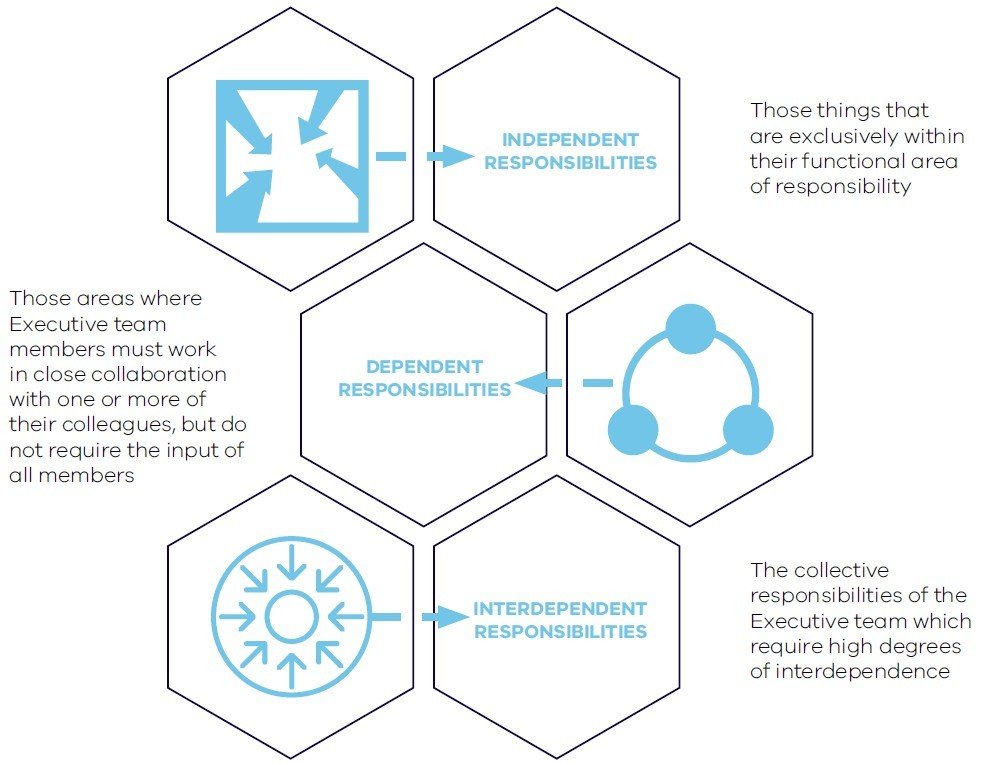The role of a true Executive Team
One of the most critical distinctions that differentiates effective teams at an Executive level is how they address the crucial Executive team question:
"What is it, that requires us to come together interdependently and for which we are collectively responsible?"
Navigating the transition from individual or functionally based accountability to organisation wide accountability is a defining characteristic of effective Executives. Clarity on exactly what is (and what is not) the business of the Executive team, is a hallmark of high-performing Executive teams.
Interdependent Responsibilities
Every Executive leader has three sets of responsibilities they must fulfil concurrently:
High-performing Executive teams are clear on what they are collectively responsible for that requires a high degree of interdependence amongst its members. Importantly, these responsibilities are limited and do not represent all things – in fact high-performing teams distinguish between the issues that need everybody’s involvement and those that need only some members involvement; where an individual expert is trusted to ‘get on with it’ and be personally accountable.
But most important of all, Executive teams organise themselves, schedule their time and structure their meetings, such that they allocate the lion’s share of the time they spend together, exclusively addressing the issues for which they are collectively responsible.
To be sure there is some review and reporting back on the dependent or independent activities of members, at times Executives might also ask for input from their colleagues on wholly independent matters, in the interest of generating new insights or solutions to particularly challenging problems. But these functions are ancillary, incidental and occupy a small proportion of the time of a high- performing Executive (in low-performing Executive teams, it often consumes all of it).
The Focus of the Executive Team
So, what are these high level, interdependent tasks that are grist for the mill of the best Executive teams?
It is a function of many factors i.e. there is no definitive list. Internal culture, external environment, the organisation’s strategy all influence where the Executive should spend its time. That said, some of the most effective teams we’ve worked with give a disproportionate amount of time and energy to issues such as:
Clarity on ‘why’ for what we do (purpose)
Creating a context and vision through a clear description of a desired future state for the organisation
Defining, articulating, promoting and repeating the strategic direction of the organisation
Regularly reviewing progress on strategic goals
Role modelling and leading through values
Defining structure, roles and accountability to support the strategy (eliminating ambiguity)
Working across boundaries, integrating the operations of different parts of the organisation
Representing the organisation to the outside world, linking it to the communities, stakeholders, sector and world within which it operates
Being the antenna to the outside world, collecting information and scanning the horizon for change
Encouraging spontaneity, flexibility and creativity
Accessing discretionary effort through effective motivation
Ensuring staff have the resources and information to get the job done
Influencing a ‘whole of organisation’ approach to talent development
Standards of Behaviour
As well as defining their purview as a team, high performing Executive teams adhere to a number of key behavioural expectations, ways of working together that differentiate functional from true Executive leadership. In essence, these involve putting the collective goals of the team ahead of their individual functional goals.
1. Check Your Hat at the Door
The role of the Executive team is to manage the strategic and operational activities of the organisation. When you’re acting as a member of an Executive team, your role is exactly the same: to manage the strategic and operational activity of the organisation.
When you’re in an Executive meeting, you’re not there to manage your department, you’re there to manage the organisation, you run your department the rest of the time. The simplest way to look at it is this - when you come into Executive team meetings, you take off your functional hat at the door. Of course, you may have to put it on again if there are specific decisions which require your subject matter expertise, or special insights that you can give because of your functional knowledge but you’ll find that this is less frequent than you might expect.
The consequence of this is that you can expect to see the following in Executive team meetings.
Everyone is expected to contribute to everything discussed, not just those matters that fall into their functional ambit
Everyone is required to help reach decisions that are for the better good of the organisation as a whole, not just ‘good for you’
2. Thinking Laterally, Not Vertically
Until becoming an Executive team member, your key relationships in the organisation are typically vertical: upward to your manager, and downward to your direct reports. From the moment you join an Executive team, your key relationships shift from the vertical to the horizontal. As of then, your first and overriding commitment will be to your peers - the other members of the Executive team.
Why?
Because your key role will be to make decisions that are for the best of the organisation as a whole, not just for your functional group. There will on occasion be conflicts between what is good for your functional area and what is good for the organisation as a whole, and when those conflicts occur, your commitment must be to the organisation as a whole - represented by your Executive team members - not to your specific functional area.
This, of course, does not mean that you can no longer be loyal to your functional group. It also doesn’t mean that you cannot lobby for their best interests or represent their needs; indeed, you are expected to do just that.
Being an effective member of an Executive team frequently means using the word ‘AND’ instead of the word ‘OR’.
For example:
Keep all the existing loyalty you have to your functional team AND add an overriding commitment to your Executive team members
Focus on delivering the key deliverables of your functional team AND place achieving organisational goals above all else
3. Cabinet Solidarity
Executive dialogue is vigorous and robust. People say what is on their minds, challenge each other and the ideas presented, sometimes it gets heated AND when the discussion is done and a decision is taken, the dynamic changes.
A cornerstone of the Westminster system of government for centuries, Cabinet Solidarity means that no matter their personal position on an issue, once a decision is made by the Executive team it is issued and upheld collectively. You can voice all your concerns and objections on any issue while it’s being discussed behind closed doors, but when a final decision is made, it’s made by all of us. When Executive team members leave the meeting room, they stand side by side on decisions, indivisibly, jointly and fully supportive of the decisions they make as a team.
The implications of this are important:
You don’t get to second-guess Executive team decisions. You don’t get to go into a colleague’s office (or worse still one of your own team) after a meeting and pick apart any decision that has been made. You don’t get to complain about or undermine any decision that has been made, to anyone outside the Executive team meeting.
You don’t get to obstruct, ignore, sandbag or avoid implementing any decisions or their implications or consequences.
You do get to be a role model in implementing agreed decisions - swiftly, fully and with enthusiasm, whatever your stance was when the decision was being debated
This doesn’t mean that Executive teams are infallible, or that people have to act like robots and persevere with the consequences of poor decisions. Executive teams make mistakes: sometimes a decision proves to have been the wrong one. When that happens, any Executive team member can bring evidence that a decision needs to be re- thought - but only after an agreed period of supportive endeavour, and only in a scheduled Executive session.
In summary, a key transition from senior functional management to Executive team membership involves going ‘meta’ to what was previously your primary concern, the successful fulfilment of your functional responsibilities.
Effective Executive teams focus their time, energy and attention on those few, critical issues that require high degrees of interdependence and for which they are prepared to take collective responsibility. When you’re acting as part of the Executive team, you should check your functional hat at the door, work laterally rather than just vertically and ensure you model and uphold Cabinet Solidarity on the decisions of the team.

